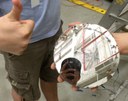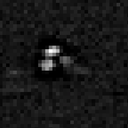SuperBIT 2016 Flight from Palestine, TX
Hi all,
tl;dr: SuperBIT finally flew. Most things worked despite some problems. Got at least 1 glamour shot of the Eagle Nebula. Telescope destroyed during recovery.
After much anticipation following our original flight readiness date of June 3, 2016, SuperBIT finally flew from Wednesday, June 30, 2016 to Thursday, July 1, 2016. Launch took place around 7:10 PM CT and termination occurred around 5:00 AM CT the following day.
A preliminary look at the overall performance before full analysis of the flight data is as follows:
i) Inner frame (telescope) pointing had similar pointing stability to the Timmins 2015 flight with control between 0.5-1" rms in pitch and roll. Yaw had significantly diminished stability around 2-3" rms for reasons that have yet to be determined. Several targets were acquired in the southern sky to within < 1', where a guide star was placed on the focal plane camera on demand.
ii) Automatic focusing of the telescope both in coarse and fine steps worked quite well. Relative focus on the focal plane camera allowed for concurrent focus on the focal plane tracking camera and the science camera.
iii) After fine focus, the fine guidance mirror (FGM) controlled by the new higher bandwidth tip-tilt actuator controller stabilized the image to < 0.1" rms during periods of highest stability, which is subpixel on the focal plane and science cameras.
iv) The telescope psf was significantly improved from the Timmins 2015 flight, but still showed indications of residual astigmatism and misalignment. This was supported by the two main blob amplitude peaks seen during telescope fine focus.
v) We got at least one glamour shot of the Eagle Nebula in several bands (Lum, R, B, U). Below is a raw unprocessed image:
vi) On recovery, the telescope optics were destroyed due to the secondary mirror and baffle falling into primary...
Given the flight performance overall, there are several major issues that will need to be addressed before the test flight in May 2017:
i) Frequently throughout the flight, we experienced significant and debilitating data drop outs, which made operations quite difficult. The cause for these drop outs is as of yet undetermined, but it seems that both the SuperBIT systems and CSBF subsystems all shared some form of data drop outs. In total, approximately 30% of all downlinked data during flight was unusable.
ii) The telescope psf was better, but still not perfect since there was evidence of residual astigmatism (see below). More specifically, at best focus, the psf had two main peaks of nearly constant relative amplitude.
PSF: pixels are 0.226"
iii) Yaw performance during this flight was significantly diminished, where the overall pointing stability was about 2-3" rms with intermittent steps and oscillations on the order of 8-10". The leading theory has something to do with the floppy SIP solar panels, which will be investigated via simulation.
iv) The focal plane camera was able to track star down to a minimum brightness of mag 9, which is not sufficient for the prospective Wanaka flight (would like at least mag 12). Even at this level, the performance of the FGM was significantly worse than for a brighter mag 7 star, which means that a more suitable focal plane camera will need to be implemented.
In addition to this, there are a few interesting things to note that we observed during the flight, which affected overall performance:
i) At float, the reaction wheel seemed to be completely dead, but after about 1 hour of panicking, a restart of the MCC seemed to fix the problem. It seemed that the DAC outputs were drifting and had saturated during ascent, though there was no evidence of this during pre-flight testing. This could have something to do with grounding on the gondola, but it is currently unclear.
ii) Although targets could easily be acquired in the southern sky, target acquisition was unsuccessful in the northern sky. This is likely software related, although pre-flight testing included target acquisition to the east, which was successful. Better methods for testing target acquisition are being investigated.
iii) The focus for the bore star camera at float was beyond the range of the focus adapter ring, which meant that the bore camera had more difficulty tracking blobs and providing lost-in-space solutions. It seems that the larger lens may be more thermally sensitive, which means that some modifications (i.e. machining) will need to be made to bring optimal focus within the focus range.
- Javier












